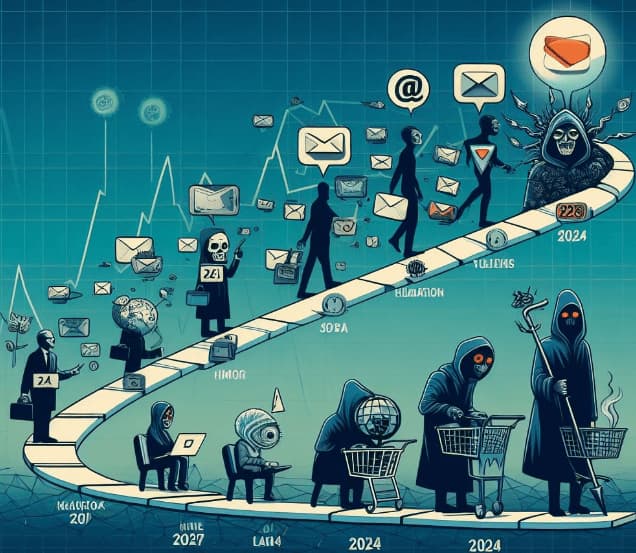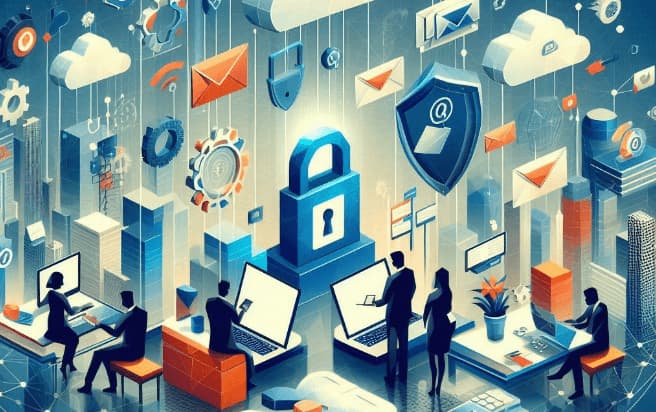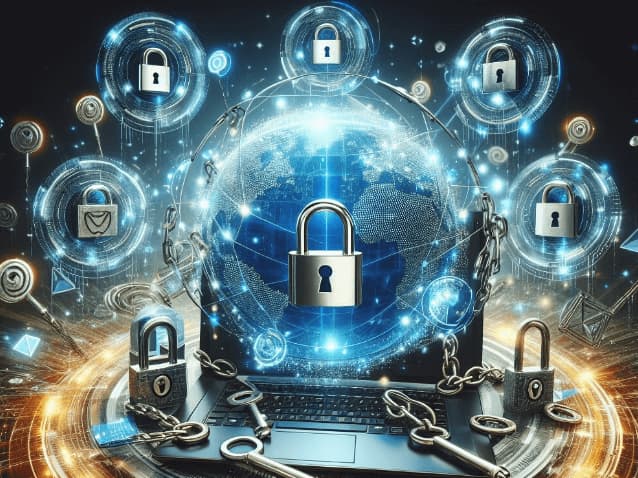This blog post, brought to you by the experts at MX Layer, aims to shed light on the ‘Top Email Security Trends for 2024.’ We will delve into the evolution of email threats leading up to 2024, discuss emerging trends in email security, and explore the increasing role of Artificial Intelligence and Machine Learning in cybersecurity. Stay with us as we equip you with the insights needed to fortify your digital communications effectively.
Mapping the Evolution of Email Threats Leading to 2024

Email threats have evolved significantly over the years, becoming more complex and harder to detect. In the early 2000s, some of the earliest phases of Business Email Compromise (BEC) scams emerged, marking the onset of social engineering tactics within emails. Examples include the notorious Nigerian Prince Scam, Lottery and Inheritance Scams, and Overpayment Scams. These schemes laid the groundwork for the sophisticated email threats prevalent today.
In 2023, against the backdrop of substantial post-pandemic societal shifts and rapid technological progress, there was a pronounced escalation in cyber threats, particularly in the realm of email-based threats. Companies noticed a significant increase in the number of emails they received compared to before, which made the risk of cyber threats even worse.
Emerging Email Threats in 2024

Email remains one of the most common vectors for cyber threats. Looking ahead to 2024, several emerging trends and challenges in email security have been identified that pose significant challenges to individuals and organizations alike:
1. Quishing or QR Code Phishing
One of the latest tactics employed by hackers is the utilization of QR codes as a means of phishing, aptly termed “Quishing.” In this method, malicious links or files are embedded within QR codes, allowing attackers to circumvent traditional email filters that lack QR code detection or reading capabilities. Unlike conventional phishing emails with visible links or attachments, QR code phishing presents a unique challenge for users, making it more difficult to identify and diagnose the threat effectively.
The number of QR code phishing cases reported in June 2023 was 5,063. Only 36% of these incidents were accurately identified and reported. The energy sector was the most vulnerable, receiving 29% of over 1,000 malware-infested phishing email QR codes. In these phishing campaigns, 26% of all malicious links were embedded in phishing QR codes. By 2025, global expenditures via QR code payments will be projected to exceed $3 trillion.
2. Growth in Targeted and Sophisticated Spear Phishing Attacks
Spear phishing, a form of targeted phishing, has witnessed a surge in sophistication and frequency. Attackers craft emails impersonating known entities, such as colleagues, vendors, or even friends, to deceive recipients into divulging sensitive information or executing malicious actions. These tailored attacks often leverage personal or company-specific information to enhance credibility and increase the likelihood of success. Spear phishing campaigns make up only 0.1% of all email-based phishing attacks, but they are responsible for 66% of all breaches.
3. Increasing Prevalence of Business Email Compromise (BEC)
BEC continues to be a pervasive threat, exploiting the weakest link in cybersecurity – human behavior. BEC attacks involve compromising legitimate email accounts or impersonating high-level executives to orchestrate fraudulent transactions, unauthorized wire transfers, or sensitive data theft. As organizations adopt advanced technologies and security measures, attackers adapt their tactics to exploit human vulnerabilities effectively. The BEC market size surged from $1.62 billion in 2023 to $1.9 billion in 2024.
4. AI-Powered Threat Detection and Response
The advent of Artificial Intelligence (AI) has ushered in a new era of cyber threats, enabling attackers to deploy more sophisticated and deceptive tactics. AI-powered algorithms can generate highly convincing phishing emails, mimicking human communication patterns and evading traditional detection mechanisms.
It’s crucial for organizations to stay informed and invest in innovative solutions, such as MX Layer, to enhance their email security posture and mitigate evolving threats effectively.
Key Email Security Challenges in 2024

The escalating sophistication of cyber threats has rendered securing email communications more challenging than ever. This section delves into the primary email security challenges faced by organizations in 2024, providing an extensive examination of the contributing factors.
Primary Email Security Challenges Faced by Organizations in 2024
1. Credential Harvesting
Credential harvesting contributes to a substantial portion of security breaches. These attacks aim to gather user credentials to gain unauthorized access to networks and sensitive information.
In 2024, 74% of security breaches implicated human involvement. These breaches occurred through various means, such as privilege misuse, utilization of stolen credentials, social engineering tactics, or human error.
2. Fileless Malware
There has been a notable surge in fileless malware incidents. This sophisticated attack vector manipulates legitimate system processes to execute malicious activities, thereby circumventing traditional detection tools. In 2023, ANY.RUN detected most malware as three different types, with loaders leading the way and stealers and RATs following.
3. Novel Malware
The emergence of new malware variants presents a significant challenge. These evolving forms of malware often elude detection, posing considerable threats to existing security infrastructures. Stealers, which focus on stealing financial information and personal data, became the second most prevalent malware type in 2023.
4. Dormant Malware
Dormant malware can lurk within systems until triggered by a specific event. Engineered to evade detection until activation, dormant malware poses a severe threat to system integrity. Loaders, the gateway for more sophisticated malware, remained a significant threat throughout the year.
5. Business Email Compromise (BEC)
BEC remains a substantial threat, with fraudsters impersonating trusted contacts to manipulate employees or clients into making security missteps. Microsoft has observed a 38 percent increase in cybercrime as a service (CaaS) targeting business email between 2019 and 2022.
Factors Contributing to These Challenges
1. Emergence of Artificial Intelligence (AI)
The rise of Artificial Intelligence has substantially facilitated deceptive tactics for malicious hackers, exacerbating the effectiveness of cyber-attacks. Nearly 69% of organizations believe they cannot respond to cyber threats without AI. Currently, 63% of breaches can be identified in minutes when AI is applied to cybersecurity.
2. Increased Use of Cloud Infrastructure
The escalating adoption of cloud infrastructure introduces diverse security challenges, including the risk of security misconfigurations stemming from inadequate awareness, the urgency to transition workloads to the cloud, negligent behavior, and decreased vigilance among remote workers. According to a recent survey, 80% of companies have experienced at least one cloud security incident in the last year.
3. Human Vulnerability
Human vulnerability remains significant, as employees can inadvertently become enablers of successful phishing attacks, underscoring the critical need for ongoing education and awareness training. Among the confirmed breaches, 74 percent implicated a human element, which could manifest as errors, privilege misuse, stolen credentials, or social engineering tactics.
4. Rapid Technological Advances
In the wake of significant post-pandemic shifts, rapid technological advancements have become ubiquitous. This influx of new trends and challenges is poised to persist, reflecting the ever-evolving landscape of technology and cybersecurity. 93% of security leaders expected to see generative AI impact their business strategies within the next five years. Moreover, AI has topped the list of emerging trends that are likely to impact the enterprise security segment in 2024.
Email Security Trends in 2024
In 2024, the landscape of email security solutions and technologies will continue to evolve rapidly to combat increasingly sophisticated attacks. Here are the current trends shaping email security:
1. Increasing Use of AI-Powered Threat Detection and Response
AI has become a cornerstone in email security, with more than 50% of security providers leveraging AI to enhance their threat detection capabilities. AI promptly identifies suspicious patterns and potential threats by analyzing email content, sender behavior, and network anomalies in real time. This trend is expected to continue, with AI becoming even more pivotal in cybersecurity by 2024.
2. Continued Adoption of Zero-Trust Email Security
Zero-trust security models are witnessing a surge in adoption, especially in email security, with an expected significant increase in 2024. This approach involves organizations scrutinizing every email sender and thoroughly verifying the content and attachments, regardless of their origin. By 2026, 10% of large enterprises will initiate a comprehensive, mature, and measurable least privilege framework by implementing zero-trust email security.
3. Enhanced Authentication Methods Will Increase
Email authentication methods like DMARC and DKIM are evolving to provide stronger authentication mechanisms. The market for multi-factor authentication (MFA) is projected to reach $20 billion by 2025, indicating a clear emphasis on bolstering authentication protocols to combat email impersonation and spoofing effectively.
4. Rise in Advanced Phishing Protection
Phishing remains a pervasive threat, with 75% of organizations experiencing at least one successful email attack in 2022. Email security solutions are increasingly adopting advanced techniques such as machine learning and behavioral analysis to counter this threat proactively. Organizations can reduce the risk of falling for scams by spotting and stopping phishing attempts.
5. Continued Rise of Cloud-Based Email Security
The adoption of cloud-based email security solutions continues to grow steadily, with the market estimated at USD 0.96 billion in 2024 and expected to reach USD 1.52 billion by 2029. These solutions offer scalable and comprehensive security measures, making them essential components of modern cybersecurity strategies.
6. An Increasing Necessity in Email Security Training and Awareness
As cyber threats evolve, organizations are investing more in advanced email security solutions and employee training to mitigate the risk of email-based attacks. This shift is evident in the transition from check-the-box compliance to a more strategic approach, as reported by 70% of corporate risk and compliance professionals in 2023.
7. An Expanding Requirement for Regulatory Compliance and Email Security
With cyber threats on the rise, governments and regulatory bodies worldwide are expected to introduce stricter regulations to protect consumers’ data. This expansion in regulatory compliance requirements underscores the importance of aligning email security practices with evolving legal frameworks to ensure compliance and mitigate regulatory risks.
Emerging Approaches and Strategies for Email Protection
In addition to current trends, emerging approaches and strategies are shaping the future of email protection:
- Enhanced Phishing Defense Techniques
As cyberattacks evolve, organizations must strengthen their phishing defense strategies. Employing cutting-edge technologies such as Machine Learning (ML) algorithms and advanced threat detection systems can help identify and intercept phishing emails before they reach users’ inboxes. By proactively mitigating phishing threats, organizations can reduce the risk of data breaches and financial losses.
- Strengthening Perimeter Defenses
Bolstering perimeter defenses through the implementation of firewalls and intrusion detection and prevention systems is crucial for protecting against phishing threats. These security measures provide an additional layer of defense, preventing unauthorized access and malicious activities from compromising email systems.
- Endpoint Protection and Endpoint Detection and Response (EDR)
Protecting individual endpoints, including laptops, desktops, and mobile devices, is paramount in defending against phishing attacks. Endpoint protection solutions coupled with Endpoint Detection and Response (EDR) capabilities, offer real-time threat detection and rapid response to security incidents. By securing endpoints, organizations can mitigate the risk of phishing-related breaches and ensure comprehensive email security.
How MX Layer Helps Against 2024’s Evolving Email Threats?

To address these challenges, MX Layer offers a comprehensive suite of features and solutions to safeguard your vital communications against emerging email threats.
- Spam, Malware, and Phishing Protection: MX Layer serves as a robust defense shield, protecting your organization against sophisticated email threats such as phishing attempts, ransomware attacks, and malware infiltration.
- Inbound and Outbound Gateway Protection: Ensuring the security of inbound and outbound emails is paramount in preventing the unwitting dissemination of threats. MX Layer’s inbound and outbound gateway protection feature meticulously scrutinizes outgoing emails to ensure they are free from any potential threats.
- Antivirus / Antispam: MX Layer’s advanced antivirus and antispam capabilities provide comprehensive protection, proactively identifying and neutralizing viruses and spam before they can infiltrate your network.
- Content Scanning: With content scanning capabilities, MX Layer inspects the content of incoming and outgoing emails, flagging any suspicious elements or potential threats for further investigation.
- Attachment Filtering: Email attachments represent a common vector for malware distribution. MX Layer’s attachment filtering feature scrutinizes attachments, mitigating the risk of malware infiltration through this avenue.
- Data Leak Prevention: The data leak prevention feature in MX Layer serves as a safeguard, stopping sensitive information from being accidentally shared outside your organization.
- URL Scanning: URLs embedded within emails can lead unsuspecting users to malicious websites. MX Layer’s URL scanning feature proactively scans URLs for potential threats, mitigating the risk of users falling victim to phishing scams or other cyberattacks.
- Zero-Hour Attack Protection: In the face of rapidly evolving threats, MX Layer’s zero-hour attack protection feature provides immediate defense against newly emerging threats, bolstering your organization’s resilience against the latest cybersecurity challenges.
Additionally, MX Layer offers essential functionalities such as Email Archiving and Email Sandboxing, further enhancing your organization’s defenses against evolving email threats:
- Email Archiving: MX Layer’s Email Archiving feature provides a comprehensive system for preserving email communications in a format conducive to digital storage, indexing, searching, and retrieval. This capability is invaluable for business continuity, disaster recovery, internal audits, investigations, e-discovery for litigation, regulatory compliance, records management, and intellectual property protection.
- Email Sandboxing: MX Layer’s Email Sandboxing feature represents a next-generation solution fortified with cutting-edge machine learning and behavioral analysis technologies. Particularly adept at countering zero-day threats, Email Sandboxing enhances defenses against malware, spear-phishing attacks, and advanced persistent threats (APTs), bolstering your organization’s cybersecurity posture in the face of evolving threats.
MX Layer provides a valuable opportunity for potential customers through its Free Trial offer, allowing them to experience the platform’s features firsthand and understand its effectiveness.
Furthermore, MX Layer prioritizes customer support by offering various channels for assistance. Current customers can access the Product Support Portal for any inquiries, ensuring prompt and efficient assistance when needed.
Conclusion
In our comprehensive exploration of the ‘Top Email Security Trends for 2024,’ powered by the expertise of MX Layer, we uncover the ever-evolving email threats and the innovative strategies emerging to combat them. In 2023, amidst significant societal shifts and rapid technological advancements, cyber threats reached unprecedented levels, intensifying the urgency for robust email security measures.
Despite increased awareness and security measures, email threats persist, with phishing, spear phishing, and the relatively newer threat of Quishing continuing to exploit vulnerabilities. Looking ahead to 2024, we anticipate a surge in Quishing attacks targeting users of platforms like Microsoft 365, alongside a rise in sophisticated spear phishing and BEC attacks. Furthermore, emerging threats such as QR Code Phishing and Vishing underscore the need for multi-layered defense strategies.
In the face of challenges, MX Layer serves as a stronghold of defense. We provide a comprehensive suite of innovative features and solutions to strengthen email security against evolving threats.






